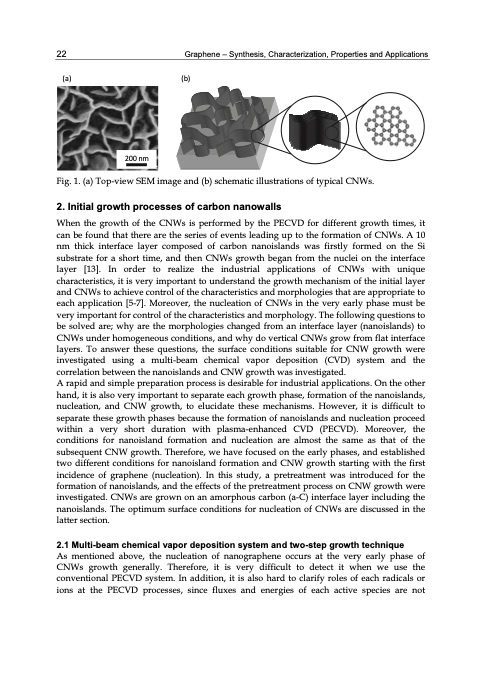
PDF Publication Title:
Text from PDF Page: 032
22 Graphene – Synthesis, Characterization, Properties and Applications (a) (b) 200 nm Fig. 1. (a) Top-view SEM image and (b) schematic illustrations of typical CNWs. 2. Initial growth processes of carbon nanowalls When the growth of the CNWs is performed by the PECVD for different growth times, it can be found that there are the series of events leading up to the formation of CNWs. A 10 nm thick interface layer composed of carbon nanoislands was firstly formed on the Si substrate for a short time, and then CNWs growth began from the nuclei on the interface layer [13]. In order to realize the industrial applications of CNWs with unique characteristics, it is very important to understand the growth mechanism of the initial layer and CNWs to achieve control of the characteristics and morphologies that are appropriate to each application [5-7]. Moreover, the nucleation of CNWs in the very early phase must be very important for control of the characteristics and morphology. The following questions to be solved are; why are the morphologies changed from an interface layer (nanoislands) to CNWs under homogeneous conditions, and why do vertical CNWs grow from flat interface layers. To answer these questions, the surface conditions suitable for CNW growth were investigated using a multi-beam chemical vapor deposition (CVD) system and the correlation between the nanoislands and CNW growth was investigated. A rapid and simple preparation process is desirable for industrial applications. On the other hand, it is also very important to separate each growth phase, formation of the nanoislands, nucleation, and CNW growth, to elucidate these mechanisms. However, it is difficult to separate these growth phases because the formation of nanoislands and nucleation proceed within a very short duration with plasma-enhanced CVD (PECVD). Moreover, the conditions for nanoisland formation and nucleation are almost the same as that of the subsequent CNW growth. Therefore, we have focused on the early phases, and established two different conditions for nanoisland formation and CNW growth starting with the first incidence of graphene (nucleation). In this study, a pretreatment was introduced for the formation of nanoislands, and the effects of the pretreatment process on CNW growth were investigated. CNWs are grown on an amorphous carbon (a-C) interface layer including the nanoislands. The optimum surface conditions for nucleation of CNWs are discussed in the latter section. 2.1 Multi-beam chemical vapor deposition system and two-step growth technique As mentioned above, the nucleation of nanographene occurs at the very early phase of CNWs growth generally. Therefore, it is very difficult to detect it when we use the conventional PECVD system. In addition, it is also hard to clarify roles of each radicals or ions at the PECVD processes, since fluxes and energies of each active species are notPDF Image | GRAPHENE SYNTHESIS CHARACTERIZATION PROPERTIES

PDF Search Title:
GRAPHENE SYNTHESIS CHARACTERIZATION PROPERTIESOriginal File Name Searched:
Graphene-Synthesis.pdfDIY PDF Search: Google It | Yahoo | Bing
Salgenx Redox Flow Battery Technology: Power up your energy storage game with Salgenx Salt Water Battery. With its advanced technology, the flow battery provides reliable, scalable, and sustainable energy storage for utility-scale projects. Upgrade to a Salgenx flow battery today and take control of your energy future.
| CONTACT TEL: 608-238-6001 Email: greg@infinityturbine.com | RSS | AMP |